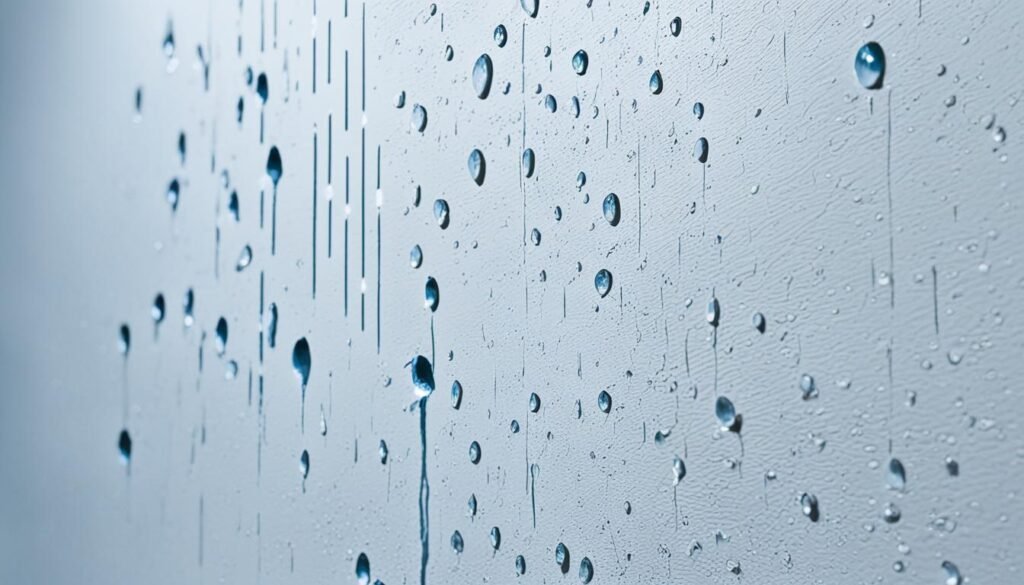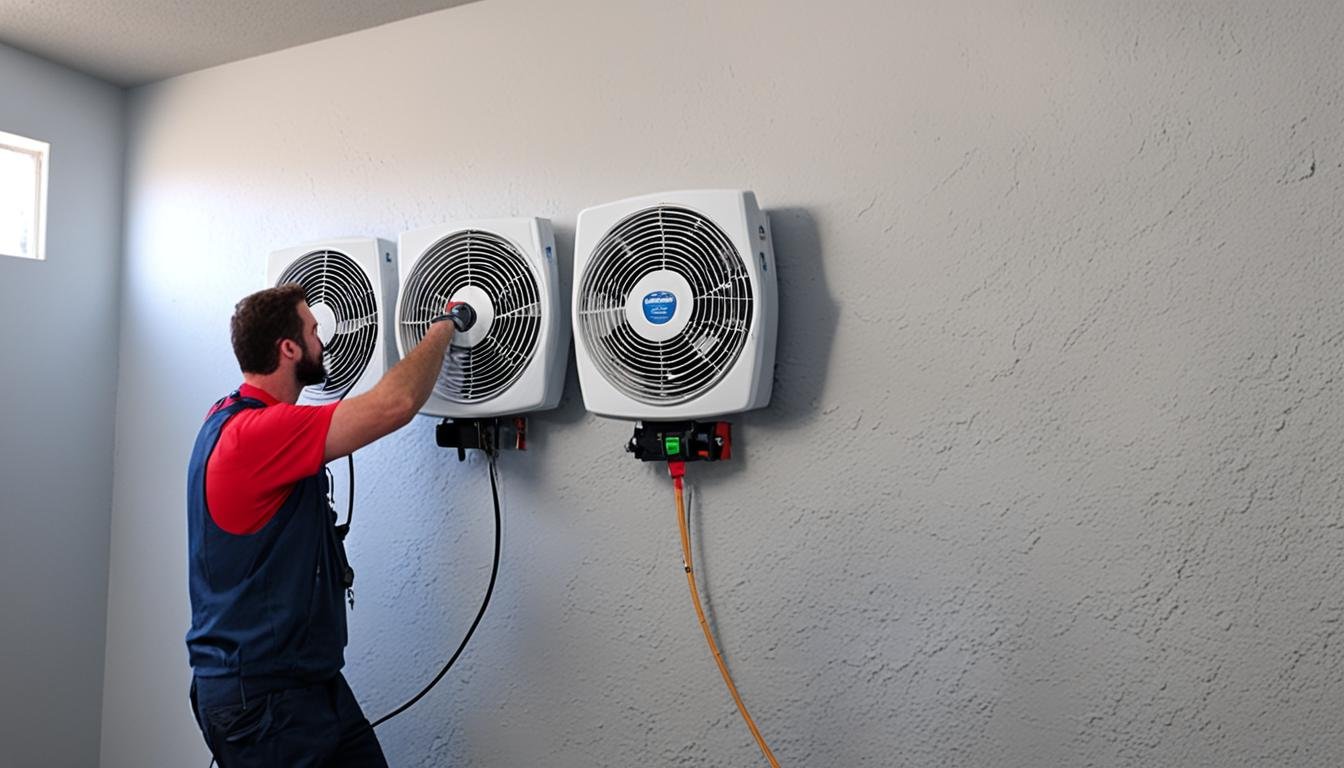Did you know cleaning up moisture-damaged walls can cost up to $7 per square foot? The average home has lots of drywall. This means water damage costs can grow fast. It’s vital to use the right methods to remove moisture. This prevents more damage, stops mold, and keeps the structure sound. Whether by plumbing issues, flooding, or humidity, knowing how to dry walls inside is crucial.
Key Takeaways
- Drywall is highly absorbent and can wick water up to 30 inches, requiring comprehensive drying on both sides of the wall
- Addressing the source of water intrusion is crucial before beginning the drying process
- Ventilation, fans, and dehumidifiers are essential for removing moisture and preventing mold growth
- Professional assistance may be needed for severe water damage or if mold is present
- Failure to properly dry walls can lead to costly structural issues and health hazards
Identifying the Source of Moisture
First, find where the moisture is coming from in the wall. It might be from leaks in plumbing, the roof, or windows. Sometimes, too much condensation can also be a problem. Once you know the cause, you can fix it directly. This helps stop more water damage in your home.
Locating Water Leaks
Start by looking closely at the wall. Look for wet spots, stains, or mold. Also, check the area’s ceilings, floors, and plumbing for leaks. If you think there’s a leak, turn off the water and investigate.
If the problem comes from a neighbor, you might have to work with them. Clear communication and teamwork are key for fixing moisture issues that cross property lines.
Draining Standing Water
If there’s water inside the wall, you need to get it out. Drill small holes near the floor to let the water escape. This action prevents structural damage and cuts down on mold.
After the water’s gone, dry out the wall. Fans and dehumidifiers help. By eliminating water and moisture, you’ll be able to dry the wall effectively. This also stops future problems.

Fixing wall moisture issues takes time and a careful approach. By finding the problem’s source and solving it correctly, you safeguard your home. This creates a better, safer living space.
Drying Techniques for Walls
First, fix the source of moisture and remove any large water pools. Then, start drying the wall’s inside. Using the right drying methods is key in stopping more water harm and mold. Let’s look at how to dry walls properly to get them back to normal.
Using Room Fans
For small wet spots, a fan can help dry them fast. Place fans facing the wet area on their top speed. The moving air will dry the wet spots by pulling out the wall’s moisture.
Employing Dehumidifiers
A big dehumidifier is good for larger wet areas. It should be able to handle 50 imp pt (28,000 ml) of water a day. Put it in the same room as the wet walls and close windows and doors. This setup helps by pulling moisture out of the air and walls.
Utilizing Desiccants
In tight spots like closets, desiccants are useful. You can use chemical packs, clay litter, or calcium chloride. These items absorb air moisture, which aids in drying the walls.
If the damage is serious or you’re unsure what to do, call experts like Water Damage Pros. They have the right tools and skills to fix water damage. This ensures no mold grows and your home stays safe after the repair.

“Prompt and effective drying of water-damaged walls is crucial to prevent mold growth and minimize the need for costly repairs.”
To dry walls successfully, first deal with the moisture source. Then, remove any standing water. Finally, use different drying methods to fully dry the walls. These steps will help get your walls back to their original state. They also protect your house from water damage problems.
How to Dry Out the Inside of a Wall
Dealing with water damage inside walls might seem tough. Yet, you can stop more harm and avoid mold by acting fast. It’s important to dry the area well.
First, find the source of water. Fix any leaks near the wall. For water inside, make small holes to let it drain out.
- Locate and repair water leaks near the affected wall.
- Drain any standing water inside the wall by drilling small holes.
- Use fans, dehumidifiers, and desiccants to actively dry the wall.
- Contact a professional restoration company, such as Water Damage Pros, if the damage is extensive or you’re unsure how to proceed.
Drying the wall actively is key. Fans help by moving the air. Dehumidifiers take moisture from the air. Desiccants like silica gel fight dampness in tight spots.
If damage is bad or you’re unsure, get help. A pro company like Water Damage Pros has what’s needed. They can quickly dry your wall to avoid big issues.
| Drying Technique | Effectiveness | Best For |
|---|---|---|
| Fans | Moderate | Small damp areas |
| Dehumidifiers | High | Large damp patches |
| Desiccants | High | Hard-to-reach areas |
Follow a clear plan to dry out your wall’s interior. This protects your home from more damage and helps it stay solid. Act quick and get help when you need it for the best results in fixing water issues.
Conclusion
Drying a wall’s inside after water damage is key. It helps stop more problems and fixes your house. By tackling where the moisture comes from, getting rid of any water, and using special methods, you can dry the wall.
This also lowers the chance of mold and harm to the structure. If handling the water damage restoration seems hard, it’s smart to get expert help. Professionals like Water Damage Pros ensure the work is right.
With the correct steps, you can dry the wall cavity thoroughly. You’ll use damp wall remediation and mold prevention strategies. These help your home go back to how it was before the damage.
Use the advice in this guide for drying the wall’s inside well. It helps your home stay safe and avoid more problems. For any expert help, go to sanbernardinowaterdamagerestoration.com or reach out to Water Damage Pros.
FAQ
What are the key steps to drying out the inside of a wall after water damage?
Why is it important to address the source of the water intrusion before drying the wall?
What are some effective techniques for drying out the inside of a wall?
When should you consider contacting a professional water damage restoration company?
How can properly drying the wall help prevent further damage and mold growth?
Source Links
- https://www.wikihow.com/Dry-Damp-Walls
- https://www.jondon.com/how-to/technical-tips/restoration-disaster-recovery/flood-recovery/drying-wall-cavities.html
- https://www.alldryus.com/blog/water/how-to-dry-out-walls-after-water-damage/
- https://www.mykukun.com/blog/how-to-remove-moisture-from-walls/
- https://www.familyhandyman.com/list/tips-for-drying-up-and-finishing-your-basement/
- https://www.timberwise.co.uk/2021/10/how-to-dry-damp-walls/
- https://www.puroclean.com/blog/how-do-i-dry-out-walls-after-water-damage/
- https://www.tapcohomedry.com/how-to-dry-damp-walls/
- https://www.servicemasterrestore.com/servicemaster-restoration-by-emt-orange-county/why-us/blog/2022/april/how-to-start-the-drying-process-restoration-of-water-damaged-walls/
- https://www.1800waterdamage.com/how-to-dry-walls/
- https://www.servicemasterrestore.com/servicemaster-trs-northeast-houston/why-us/blog/2021/february/how-to-dry-walls-better-after-a-water-leak/
- https://www.ncbi.nlm.nih.gov/books/NBK215649/
- https://www.thisoldhouse.com/foundations/reviews/how-to-dry-a-basement
- https://mykukun.com/blog/how-to-remove-moisture-from-walls/


